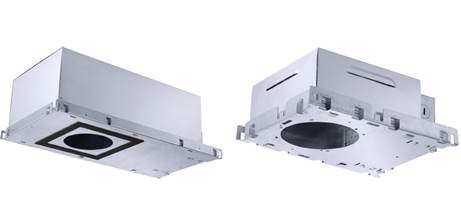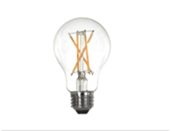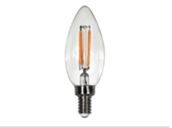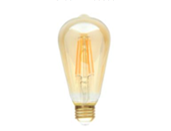
A luminaire, which is a light fixture, is defined by §100.1 as a complete lighting unit consisting of a light source such as a lamp or lamps and the parts that distribute the light, position and protect the light source and connect it to the power supply.
A lamp is a light bulb or similar separable lighting component. It is defined by §100.1 as an electrical appliance that produces optical radiation for visual illumination with a base to provide an electrical connection between the lamp and a luminaire, and installed into a luminaire. The definition is expanded to clarify that a lamp is not a luminaire and is not an LED retrofit kit designed to replace additional components of a luminaire.
The 2019 Energy Standards for residential lighting require all permanently installed luminaires to be high efficacy, as specified in §150.0(k) Permanently installed lighting is defined in §100.1 and examples of permanently installed lighting include:
•Lighting attached to walls, ceilings, or columns.
•Track and flexible lighting systems.
•Lighting inside permanently installed cabinets.
•Lighting attached to the top or bottom of permanently installed cabinets.
•Lighting attached to ceiling fans.
•Lighting integral to exhaust fans.
•Lighting integral to garage door openers if it is used as general lighting, is switched independently from the garage door opener, and does not automatically turn off after a pre-determined amount of time.
The following are examples of non-permanently installed lighting:
•Portable lighting as defined by §100.1 (including, but not limited to, table and freestanding floor lamps with plug-in connections);
•Lighting installed by the manufacturer in refrigerators, stoves, microwave ovens, exhaust hoods for cooking equipment, refrigerated cases, vending machines, food preparation equipment, and scientific and industrial equipment;
•Lighting in garage door openers which consists of no more than two screw-based sockets integrated into the garage door opener by the manufacturer, where the lights automatically turn on when the garage door is activated, and automatically turn off after a pre-determined amount of time.
Luminaires in any of the following categories are automatically classified as high efficacy and do not have to comply with the requirements of Reference Joint Appendix JA8 (aka JA8 – refer to next section for details).
a. Pin-based linear fluorescent luminaires using electronic ballasts.
b. Pin-based compact fluorescent luminaires using electronic ballasts
c. Pulse-start metal halide luminaires.
d. High pressure sodium luminaires.
e. Luminaires with induction lamp and hardwired high frequency generator.
f. LED luminaires installed outdoors.
g. Inseparable solid state lighting (SSL) luminaires containing colored light sources for decorative lighting purpose.
Recessed downlight luminaires must meet the JA8 requirements.
Screw-based luminaire types must have a JA8-compliant light source or lamp installed in them at the time of inspection.
All other luminaire types must also meet the JA8 requirements.
Table 6-1 summarizes the requirements for residential high-efficacy luminaires. There are luminaires automatically classified as high efficacy, luminaires that must use JA8-certified light sources or lamps, and recessed downlight luminaires in ceilings.
|
High-Efficacy Luminaires* |
JA8 High-Efficacy Lighting – Lamps and Light Sources that must be JA8-certified |
*Recessed Downlight Luminaires in Ceilings |
|
•Pin-based linear fluorescent light sources using electronic ballasts •Pin-based compact fluorescent light sources using electronic ballasts •Pulse-start metal halide light sources •High-pressure sodium light sources •Luminaires with induction lamp and hardwired high frequency generator •LED light sources installed outdoors
|
•Light sources installed in ceiling recessed downlight luminaires. The downlights shall not have screw bases. •LED luminaires with integral sources •Screw-based LED lamps (A-lamps, PAR lamps, etc.) •Pin-based LED lamps (MR-16, AR-111, etc.) •Any light source or luminaire not listed elsewhere in this table |
•Shall not have screw-based sockets •Shall contain JA8 -certified light sources •Shall meet all performance requirements in §150.0(k)1C |
Luminaires not listed in the previous section must have an integral light source or removable lamp that meets the performance requirements of JA8 . The requirements in JA8 ensure that new lighting technologies like LED provide energy-efficient light, while also maintaining performance characteristics that customers expect. In addition to setting minimum efficacy requirements, JA8 establishes performance requirements that ensure accurate color rendition, dimmability, and reduced noise and flicker during operation.
Luminaires with integral sources, such as LED luminaires, must be certified by the Energy Commission as meeting the JA8 requirements. Luminaires that have changeable lamps (such as screw-base luminaires) must be installed with lamps that have been certified by the Energy Commission.
Luminaires and lamps that the Energy Commission certified must be marked with JA8-2019 or JA8-2019-E on the product. The JA8-2019-E marking indicates that the product has passed the more stringent ENERGY STAR’s Elevated Temperature Life test as specified in Reference Joint Appendix JA8 of Section JA8.3.5. The product is appropriate for elevated temperature applications for installation such as in enclosed luminaires.
Luminaires that can be classified as high efficacy by meeting the requirements of JA8 include:
1. LED luminaires with integral light sources that are certified to the Energy Commission.
2. Screw-based luminaires with JA8-certified lamps.
3. Low-voltage pin-based luminaires with JA8-certified lamps.
Almost any luminaire can be classified as high efficacy, as long as the luminaire is installed with a JA8 compliant lamp. The exception is recessed downlight luminaires in ceilings, which must meet additional requirements.
The Energy Commission maintains a database of certified JA8-compliant luminaires, lamps, and light sources. The database can be accessed using a Quick Search Tool
(https://cacertappliances.energy.ca.gov/Pages/ApplianceSearch.aspx)
or an Advanced Search (https://cacertappliances.energy.ca.gov/Pages/Search/AdvancedSearch.aspx).
In addition to the high-efficacy requirements, there are several additional requirements for residential downlight luminaires that are recessed in ceilings.
Figure 6-1 Recessed Downlight Luminaires in Ceiling

Source: © 2018 Lutron Electronics Co., Inc. All rights reserved.
The first set of requirements limit the light sources and lamp types used in recessed downlight luminaires. Recessed downlights:
1. Shall contain light sources that are JA8-certified.
2. Shall not contain screw-based lamps.
3. Shall not contain light sources that are labeled not for use in enclosed fixtures or not for use in recessed fixtures.
All recessed downlight luminaires must contain a light source or lamp that is JA8-certified, such as an integral LED source or LED lamp. Screw-based lamps such as LED A-lamps or LED PAR lamps are not allowed. Pin-based lamps such as LED MR-16 lamps are allowed in recessed fixtures as long as they are JA8-certified.
In addition to the light source and lamp requirements listed, recessed downlight luminaires in ceilings must also meet all the following performance requirements:
1. Be listed for zero clearance insulation contact (IC) by Underwriters Laboratories or another nationally recognized testing/rating laboratory;
2. Have a label that certifies the luminaire is airtight with air leakage less than 2.0 cubic feet per minute (CFM) at 75 Pascals when tested in accordance with ASTM E283 (exhaust fan housings are not required to be airtight);
3. Be sealed with a gasket or caulk between the luminaire housing and ceiling, and have all air leak paths between conditioned and unconditioned spaces sealed with a gasket or caulk;
4. For luminaires with hardwired ballasts or drivers, allow ballast or driver maintenance and replacement to be readily accessible to building occupants from below the ceiling without requiring holes to be cut in the ceiling.
Luminaires that meet the first two performance criteria will list this information on luminaire cut sheets or packaging. Contractors are responsible to ensure that luminaires are properly sealed, and any ballasts or drivers are accessible.
Recessed downlight luminaires that do not meet all requirements cannot be used for residential lighting.
Figure 6-2 Recessed Luminaire with an
IC Housing (left);
Recessed Luminaire with a Non-IC Housing (right)

Source: © 2018 Lutron Electronics Co., Inc. All rights reserved.
For recessed luminaires to be installed in new residential spaces, the installed light sources and lamps shall be JA8-compliant to meet the elevated temperature requirement. The JA8-compliant lamps and light sources shall have the JA8-2019-E marking to signify that it can be installed in an enclosed luminaire.
Any enclosed luminaire to be installed in residential spaces shall be used with JA8-compliant lamps or light sources meeting the elevated temperature requirement. The JA8-compliant lamps and light sources shall have the JA8-2019-E marking to signify that it can be installed in an enclosed luminaire.
The certified JA8-compliant lamps and light sources can be looked at in the Energy Commission’s Appliance Database by going to https://cacertappliances.energy.ca.gov/Pages/ApplianceSearch.aspx.
Figure 6-3 Images of JA8-2019-E Compliant Lamps



Source: Maxlite
For screw-based luminaires to be installed in residential spaces, the installed lamps shall be JA8-compliant lamps.
Night lights, step lights and path lights can be installed by complying with the residential lighting requirement of the Energy Code by either:
1. The luminaire complies with Table 150.0-A (A short version of the table is at page 6-4);
2. The luminaire is controlled by a vacancy sensor as required under Section 150.0(k)2I in applicable spaces (bathrooms, garages, laundry rooms and utility rooms). It is rated no more than 5 watts (W) of power and emits no more than 150 lumens.
Light sources in drawers, cabinets, and linen closets can be installed by complying with the residential lighting requirement of the Energy Code by either:
1. The luminaire complies with Table 150.0-A (A short version of the table is at page 6-4) ;
2. The luminaire is controlled to be automatically off when the drawer, cabinet or linen closet is closed, and is also controlled by a vacancy sensor as required under 150.0(k)2l in applicable spaces (bathrooms, garages, laundry rooms and utility rooms). The luminaire is rated no more than 5W of power and emits no more than 150 lumens.
Example 6-1: Screw-based luminaires
Question
I am using a screw-based luminaire that is rated to take a 60W lamp for lighting over a sink, and I plan to install a 10W LED lamp. Does it meet the residential lighting requirement for screw-based luminaire and Table 150.0-A?
Answer
If the LED lamp is JA8 -certified and marked JA8-2019 or JA8-2019-E, then it meets the residential lighting requirement on screw-based luminaire and Table 150.0-A.
Example 6-2: Color-tunable and dim-to-warm luminaires installed in residential buildings
Question
Can color-tunable luminaires and dim-to-warm luminaires be certified to meet JA8 specifications?
Answer
The JA8 specifications require the color temperature (correlated color temperature, CCT) of the light sources to be no greater than 4000 Kelvin (K). If the color-tunable luminaire product or the dim-to-warm luminaire product produces a color temperature of no greater than 4000K, it meets the color temperature criteria of JA8.
Example 6-3: Fade-in lighting
Question
I would like to use lighting with an aesthetic fade-in feature in my design. The Joint Appendix JA8 has a start time requirement. Are fade-in lights able to qualify as high efficacy?
Answer
Aesthetic fade-in lights are acceptable under Title 24. The test procedure for start time measures “[t]he time between the application of power to the device and the point where the light output reaches 98% of the lamp’s initial plateau.” The “initial plateau” is “[t]he points at which the average increase in the light output over time levels out (reduces in slope).”
For light sources with a fade-in feature, the light output intentionally follows a programmed fade-in curve to increase light output gradually. Because the light output must level out, the initial plateau for these light sources is the point in time at which there is perceived light output and the perceived light increase begins to follow the programmed fade-in curve. The programmed fade-in curve is expected to be continuously increasing as a function of time.
This allows fade-in lighting to qualify as high efficacy.
Example 6-4: Kitchens exhaust hood lighting
Question
I am installing an exhaust hood over my kitchen range that has lamps in it. Do these lamps have to be high efficacy?
Answer
This lighting is part of an appliance and does not have to meet the residential lighting requirements for permanently installed lighting.
Example 6-5: Kitchen alterations
Question
I am designing a residential kitchen lighting system with six 12W LED recessed downlights and four 24W LED tape lights for under cabinet lighting. How many watts of incandescent or halogen luminaires can be installed?
Answer
None. Low efficacy luminaires are no longer allowed for residential lighting. All luminaires must meet the definitions of high-efficacy luminaires in Table 150.0-A of the Energy Standards.
Example 6-6: Night lights
Question
Where are night lights permitted to be installed in residential buildings?
Answer
There are no location restrictions in the Energy Standards. Permanently installed night lights and night lights integral to installed luminaires can be installed anywhere in single family buildings, dwelling units of multifamily buildings, or other residential spaces.
For blank electrical boxes mounted more than 5 feet above the finished floor, the boxes shall be served by a dimmer, vacancy sensor, or fan speed control.
Example 6-7: Blank electrical boxes
Question
How many blank electrical boxes located more than 5 feet above the finished floor can be installed in a residential building or space?
Answer
The number of boxes can be as many as the number of bedrooms in a residential building or dwelling unit. The number of boxes can be less but not more than the number of bedrooms.
This requirement applies to those located more than 5 feet above the finished floor. It does not apply to boxes mounted below 5 feet or at 5 feet above the floor.